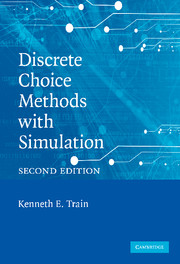1 - Introduction
Published online by Cambridge University Press: 05 June 2012
Summary
Motivation
When I wrote my first book, Qualitative Choice Analysis, in the mid-1980s, the field had reached a critical juncture. The breakthrough concepts that defined the field had been made. The basic models – mainly logit and nested logit – had been introduced, and the statistical and economic properties of these models had been derived. Applications had proven successful in many different areas, including transportation, energy, housing, and marketing – to name only a few.
The field is at a similar juncture today for a new generation of procedures. The first-generation models contained important limitations that inhibited their applicability and realism. These limitations were well recognized at the time, but ways to overcome them had not yet been discovered. Over the past twenty years, tremendous progress has been made, leading to what can only be called a sea change in the approach and methods of choice analysis. The early models have now been supplemented by a variety of more powerful and more flexible methods. The new concepts have arisen gradually, with researchers building on the work of others. However, in a sense, the change has been more like a quantum leap than a gradual progression. The way that researchers think about, specify, and estimate their models has changed. Importantly, a kind of consensus, or understanding, seems to have emerged about the new methodology. Among researchers working in the field, a definite sense of purpose and progress prevails.
- Type
- Chapter
- Information
- Discrete Choice Methods with Simulation , pp. 1 - 8Publisher: Cambridge University PressPrint publication year: 2009



